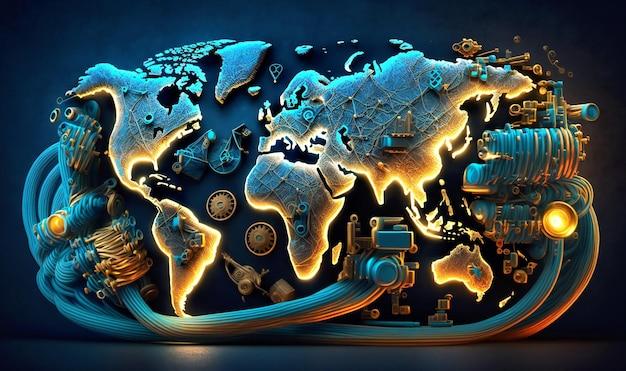In a world where instantaneous communication and information sharing are the norm, the undersea cables that crisscross the ocean floor play a critical role in enabling global internet access. While these cables are often overlooked and taken for granted, the reality is that the vast majority of international internet traffic relies on a mere few hundred of these vulnerable and essential lifelines. Join us as we delve into the intricate network of undersea cables that power the digital world as we know it, and explore the potential risks and challenges that come with this vital infrastructure.
The Critical Role of Undersea Cables in Global Internet Connectivity
Undersea cables play a pivotal role in ensuring global internet connectivity, serving as the backbone for the vast network that connects people, businesses, and countries worldwide. These cables, stretching across oceans and seas, transmit data at high speeds, enabling seamless communication and information exchange on a global scale.
Despite their critical importance, undersea cables are vulnerable to damage from natural disasters, human activities, and even shark attacks. With just a few hundred cables responsible for carrying the majority of internet traffic, any disruptions to these vital links can have far-reaching consequences, impacting everything from international trade to social media usage. It is essential for stakeholders to prioritize the maintenance and protection of these undersea cables to safeguard the world’s access to the internet.
Vulnerabilities and Risks Facing Undersea Cables
Undersea cables are the backbone of global internet connectivity, facilitating the transfer of massive amounts of data across continents at lightning speed. However, these cables are not immune to vulnerabilities and risks that can disrupt the flow of information worldwide. Some of the key challenges facing undersea cables include:
- Physical damage: Ships, anchors, and natural disasters pose a significant threat to undersea cables, leading to costly repairs and downtime.
- Cybersecurity threats: Hackers may attempt to intercept or tamper with data transmission through undersea cables, compromising the security and privacy of information.
- Geopolitical tensions: Undersea cables are vulnerable to sabotage or interference by state actors during times of conflict or political instability.
- Regular Maintenance: Conducting routine inspections and repairs to detect and address any potential issues before they escalate.
- Diversification of Routes: Building multiple cable routes to reduce the risk of a single point of failure impacting global connectivity.
Despite these risks, the global internet heavily relies on a few hundred undersea cables for seamless connectivity. Safeguarding these critical infrastructure components is essential to ensuring the uninterrupted flow of information across borders and oceans.
Measures to Strengthen Undersea Cable Infrastructure
Undersea cables play a crucial role in connecting continents and regions, enabling global internet access for billions of people. However, these cables are inherently vulnerable to natural disasters, anchor damage, and even malicious attacks. To strengthen undersea cable infrastructure and ensure the reliability of internet connectivity, several measures can be implemented:
Furthermore, investing in advanced technologies such as fiber-optic cables and protective coatings can help enhance the resilience of undersea cable networks. By taking proactive steps to fortify undersea cable infrastructure, we can safeguard the backbone of the internet and ensure seamless communication across the globe.
Ensuring Resilient Global Internet Access Through Diverse Cable Routes
Many people take for granted the seamless internet access they enjoy on a daily basis, not realizing that this connectivity is made possible by a relatively small number of undersea cables that crisscross the ocean floors. These cables, made up of fiber-optic strands, serve as the backbone of global internet communication, transferring vast amounts of data across continents in milliseconds.
Despite their critical importance, these undersea cables are vulnerable to a variety of threats, including natural disasters, fishing activities, and even intentional sabotage. As a result, ensuring resilient global internet access requires the implementation of diverse cable routes that can bypass potential points of failure. In an increasingly interconnected world, the reliability and security of these undersea cables are paramount to maintaining uninterrupted internet connectivity for billions of people worldwide.
To Conclude
As we navigate the intricate web of global internet connectivity, it becomes increasingly apparent that our reliance on a mere few hundred undersea cables carries with it a delicate balance of vulnerability and resilience. The intricate dance of these cables beneath the surface of our seas connects us all in ways we often take for granted. Let us marvel at the invisible highways of information that crisscross our planet, and remember the importance of safeguarding these vital connections for a truly interconnected world.
